HSTY2711 Take-Home Exam: Revolutionary Europe Analysis
VerifiedAdded on 2022/12/28
|7
|1569
|37
Essay
AI Summary
This essay delves into the crucial revolutions that occurred in Europe between 1780 and 1920, focusing on the decline of monarchies and the rise of democratic ideals. It examines three pivotal events: the French Revolution of 1789-1799, the Serbian Revolution (1805-1830), and the German Revolution of 1918. The essay analyzes the causes, key events, and outcomes of each revolution, highlighting the role of socio-economic factors, class struggles, and the impact of war. It argues that these revolutions, despite varying in nature, shared a common thread of challenging existing power structures and advocating for greater political and social freedoms. The essay underscores the significance of these events in shaping the trajectory of modern Europe and the evolution of democratic practices.

1
Paraphrase This Document
Need a fresh take? Get an instant paraphrase of this document with our AI Paraphraser

Contents
Introduction................................................................................................................................3
The decline of the Monarchies and Churches during the French Revolution of 1789-1799. 4
The origin of the principality of Serbia is an outcome of the Revolt.....................................4
The toll of war that resulted in the German Revolution of 1918............................................5
Conclusion..................................................................................................................................6
2
Introduction................................................................................................................................3
The decline of the Monarchies and Churches during the French Revolution of 1789-1799. 4
The origin of the principality of Serbia is an outcome of the Revolt.....................................4
The toll of war that resulted in the German Revolution of 1918............................................5
Conclusion..................................................................................................................................6
2
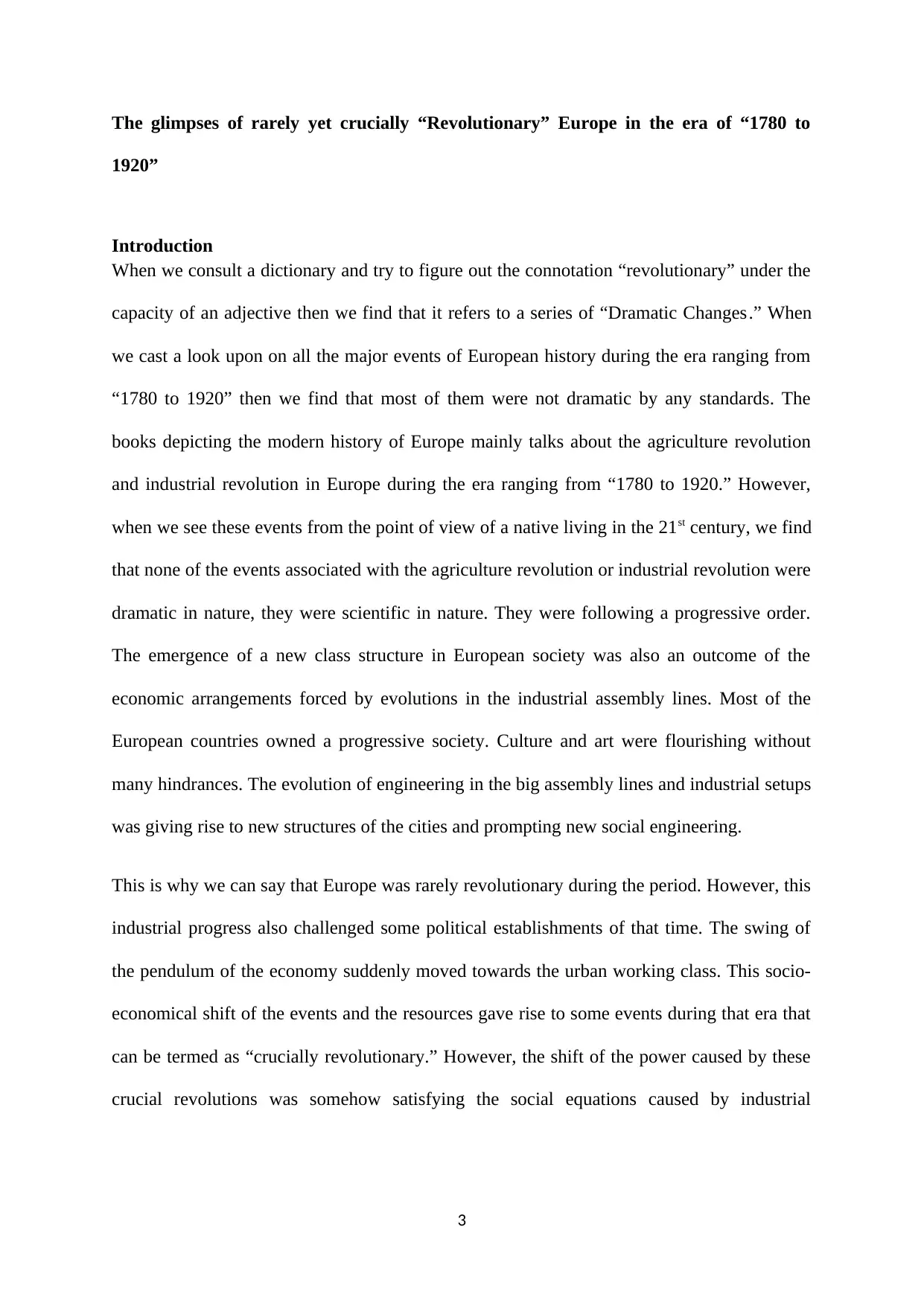
The glimpses of rarely yet crucially “Revolutionary” Europe in the era of “1780 to
1920”
Introduction
When we consult a dictionary and try to figure out the connotation “revolutionary” under the
capacity of an adjective then we find that it refers to a series of “Dramatic Changes.” When
we cast a look upon on all the major events of European history during the era ranging from
“1780 to 1920” then we find that most of them were not dramatic by any standards. The
books depicting the modern history of Europe mainly talks about the agriculture revolution
and industrial revolution in Europe during the era ranging from “1780 to 1920.” However,
when we see these events from the point of view of a native living in the 21st century, we find
that none of the events associated with the agriculture revolution or industrial revolution were
dramatic in nature, they were scientific in nature. They were following a progressive order.
The emergence of a new class structure in European society was also an outcome of the
economic arrangements forced by evolutions in the industrial assembly lines. Most of the
European countries owned a progressive society. Culture and art were flourishing without
many hindrances. The evolution of engineering in the big assembly lines and industrial setups
was giving rise to new structures of the cities and prompting new social engineering.
This is why we can say that Europe was rarely revolutionary during the period. However, this
industrial progress also challenged some political establishments of that time. The swing of
the pendulum of the economy suddenly moved towards the urban working class. This socio-
economical shift of the events and the resources gave rise to some events during that era that
can be termed as “crucially revolutionary.” However, the shift of the power caused by these
crucial revolutions was somehow satisfying the social equations caused by industrial
3
1920”
Introduction
When we consult a dictionary and try to figure out the connotation “revolutionary” under the
capacity of an adjective then we find that it refers to a series of “Dramatic Changes.” When
we cast a look upon on all the major events of European history during the era ranging from
“1780 to 1920” then we find that most of them were not dramatic by any standards. The
books depicting the modern history of Europe mainly talks about the agriculture revolution
and industrial revolution in Europe during the era ranging from “1780 to 1920.” However,
when we see these events from the point of view of a native living in the 21st century, we find
that none of the events associated with the agriculture revolution or industrial revolution were
dramatic in nature, they were scientific in nature. They were following a progressive order.
The emergence of a new class structure in European society was also an outcome of the
economic arrangements forced by evolutions in the industrial assembly lines. Most of the
European countries owned a progressive society. Culture and art were flourishing without
many hindrances. The evolution of engineering in the big assembly lines and industrial setups
was giving rise to new structures of the cities and prompting new social engineering.
This is why we can say that Europe was rarely revolutionary during the period. However, this
industrial progress also challenged some political establishments of that time. The swing of
the pendulum of the economy suddenly moved towards the urban working class. This socio-
economical shift of the events and the resources gave rise to some events during that era that
can be termed as “crucially revolutionary.” However, the shift of the power caused by these
crucial revolutions was somehow satisfying the social equations caused by industrial
3
⊘ This is a preview!⊘
Do you want full access?
Subscribe today to unlock all pages.

Trusted by 1+ million students worldwide
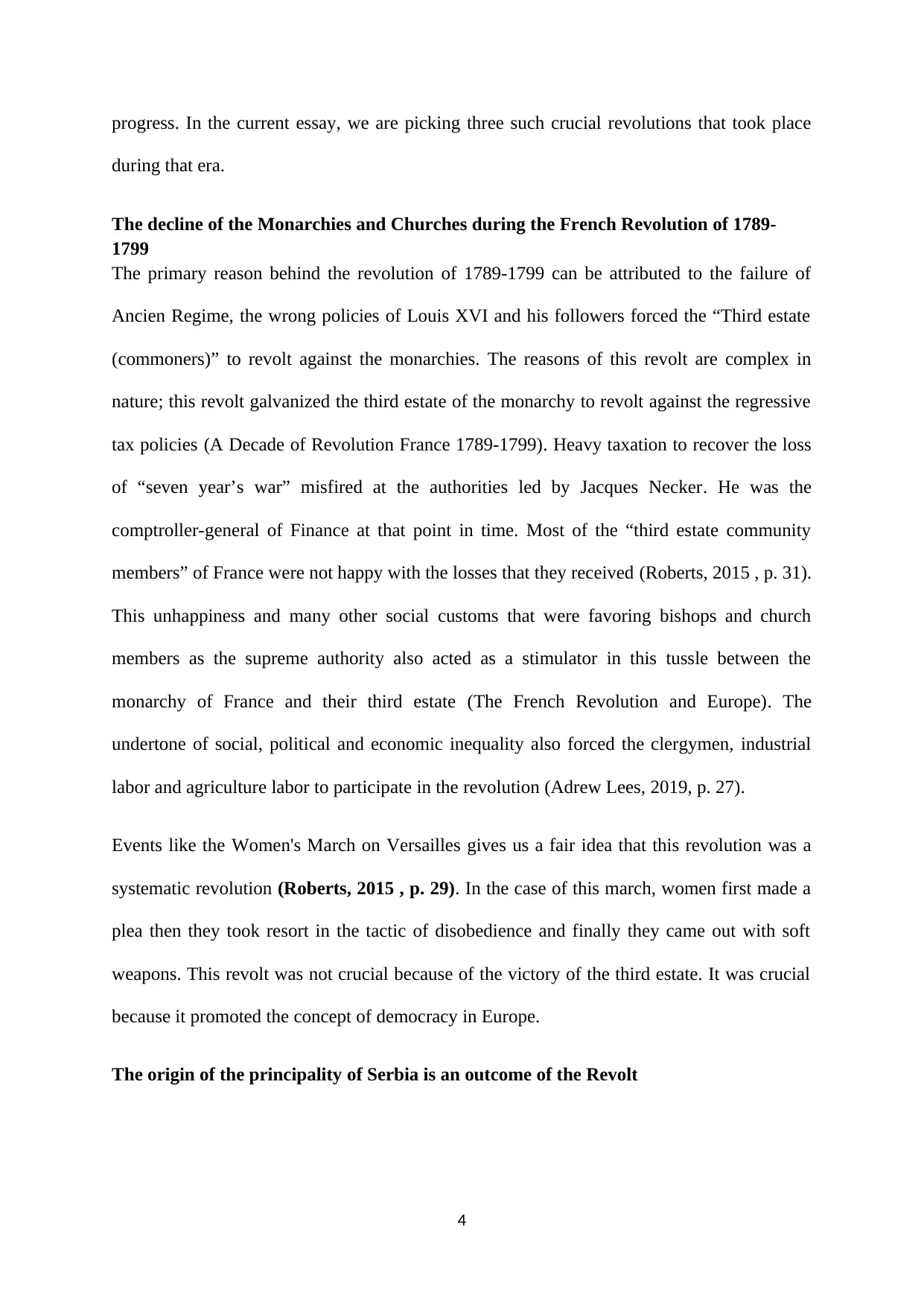
progress. In the current essay, we are picking three such crucial revolutions that took place
during that era.
The decline of the Monarchies and Churches during the French Revolution of 1789-
1799
The primary reason behind the revolution of 1789-1799 can be attributed to the failure of
Ancien Regime, the wrong policies of Louis XVI and his followers forced the “Third estate
(commoners)” to revolt against the monarchies. The reasons of this revolt are complex in
nature; this revolt galvanized the third estate of the monarchy to revolt against the regressive
tax policies (A Decade of Revolution France 1789-1799). Heavy taxation to recover the loss
of “seven year’s war” misfired at the authorities led by Jacques Necker. He was the
comptroller-general of Finance at that point in time. Most of the “third estate community
members” of France were not happy with the losses that they received (Roberts, 2015 , p. 31).
This unhappiness and many other social customs that were favoring bishops and church
members as the supreme authority also acted as a stimulator in this tussle between the
monarchy of France and their third estate (The French Revolution and Europe). The
undertone of social, political and economic inequality also forced the clergymen, industrial
labor and agriculture labor to participate in the revolution (Adrew Lees, 2019, p. 27).
Events like the Women's March on Versailles gives us a fair idea that this revolution was a
systematic revolution (Roberts, 2015 , p. 29). In the case of this march, women first made a
plea then they took resort in the tactic of disobedience and finally they came out with soft
weapons. This revolt was not crucial because of the victory of the third estate. It was crucial
because it promoted the concept of democracy in Europe.
The origin of the principality of Serbia is an outcome of the Revolt
4
during that era.
The decline of the Monarchies and Churches during the French Revolution of 1789-
1799
The primary reason behind the revolution of 1789-1799 can be attributed to the failure of
Ancien Regime, the wrong policies of Louis XVI and his followers forced the “Third estate
(commoners)” to revolt against the monarchies. The reasons of this revolt are complex in
nature; this revolt galvanized the third estate of the monarchy to revolt against the regressive
tax policies (A Decade of Revolution France 1789-1799). Heavy taxation to recover the loss
of “seven year’s war” misfired at the authorities led by Jacques Necker. He was the
comptroller-general of Finance at that point in time. Most of the “third estate community
members” of France were not happy with the losses that they received (Roberts, 2015 , p. 31).
This unhappiness and many other social customs that were favoring bishops and church
members as the supreme authority also acted as a stimulator in this tussle between the
monarchy of France and their third estate (The French Revolution and Europe). The
undertone of social, political and economic inequality also forced the clergymen, industrial
labor and agriculture labor to participate in the revolution (Adrew Lees, 2019, p. 27).
Events like the Women's March on Versailles gives us a fair idea that this revolution was a
systematic revolution (Roberts, 2015 , p. 29). In the case of this march, women first made a
plea then they took resort in the tactic of disobedience and finally they came out with soft
weapons. This revolt was not crucial because of the victory of the third estate. It was crucial
because it promoted the concept of democracy in Europe.
The origin of the principality of Serbia is an outcome of the Revolt
4
Paraphrase This Document
Need a fresh take? Get an instant paraphrase of this document with our AI Paraphraser
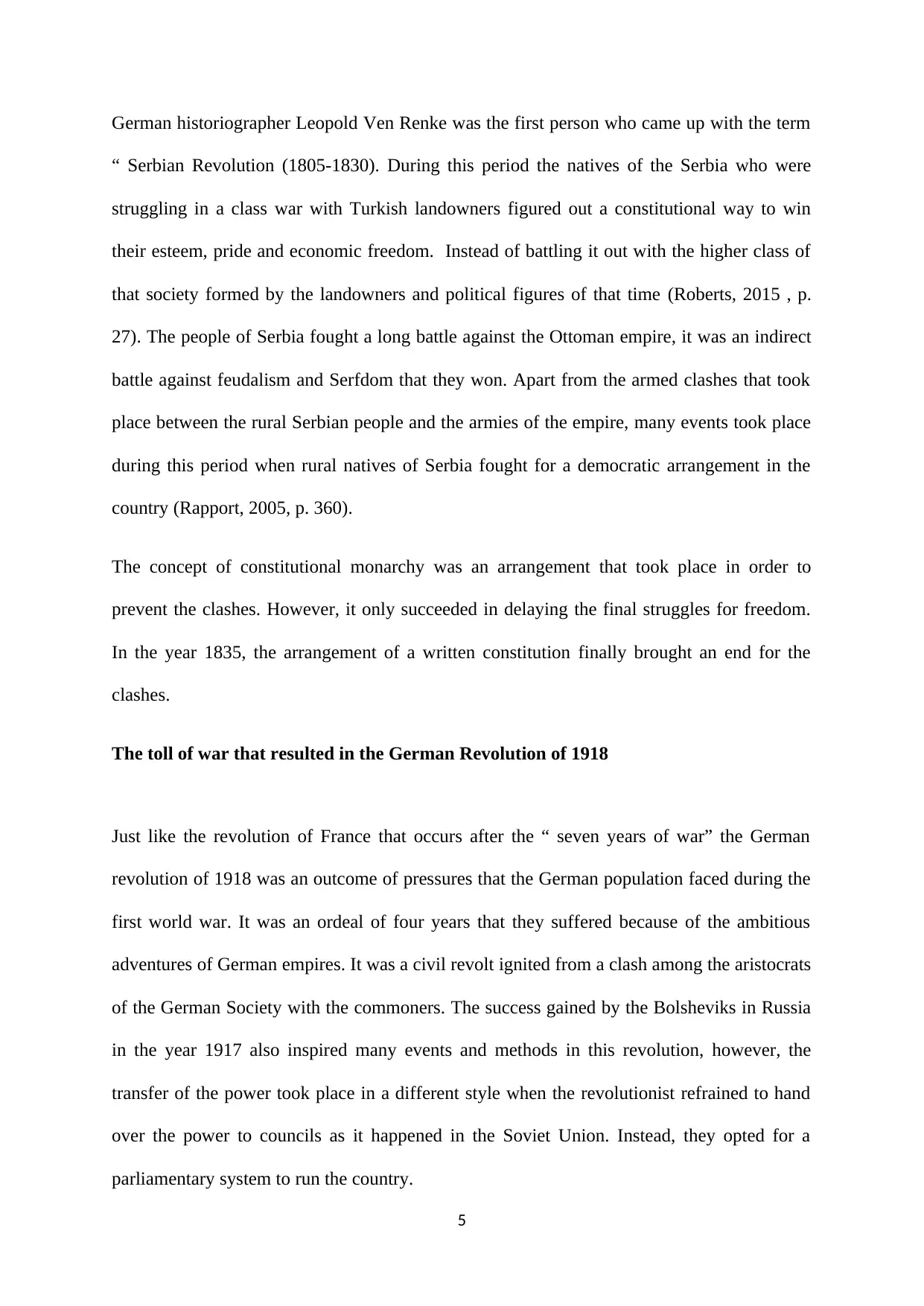
German historiographer Leopold Ven Renke was the first person who came up with the term
“ Serbian Revolution (1805-1830). During this period the natives of the Serbia who were
struggling in a class war with Turkish landowners figured out a constitutional way to win
their esteem, pride and economic freedom. Instead of battling it out with the higher class of
that society formed by the landowners and political figures of that time (Roberts, 2015 , p.
27). The people of Serbia fought a long battle against the Ottoman empire, it was an indirect
battle against feudalism and Serfdom that they won. Apart from the armed clashes that took
place between the rural Serbian people and the armies of the empire, many events took place
during this period when rural natives of Serbia fought for a democratic arrangement in the
country (Rapport, 2005, p. 360).
The concept of constitutional monarchy was an arrangement that took place in order to
prevent the clashes. However, it only succeeded in delaying the final struggles for freedom.
In the year 1835, the arrangement of a written constitution finally brought an end for the
clashes.
The toll of war that resulted in the German Revolution of 1918
Just like the revolution of France that occurs after the “ seven years of war” the German
revolution of 1918 was an outcome of pressures that the German population faced during the
first world war. It was an ordeal of four years that they suffered because of the ambitious
adventures of German empires. It was a civil revolt ignited from a clash among the aristocrats
of the German Society with the commoners. The success gained by the Bolsheviks in Russia
in the year 1917 also inspired many events and methods in this revolution, however, the
transfer of the power took place in a different style when the revolutionist refrained to hand
over the power to councils as it happened in the Soviet Union. Instead, they opted for a
parliamentary system to run the country.
5
“ Serbian Revolution (1805-1830). During this period the natives of the Serbia who were
struggling in a class war with Turkish landowners figured out a constitutional way to win
their esteem, pride and economic freedom. Instead of battling it out with the higher class of
that society formed by the landowners and political figures of that time (Roberts, 2015 , p.
27). The people of Serbia fought a long battle against the Ottoman empire, it was an indirect
battle against feudalism and Serfdom that they won. Apart from the armed clashes that took
place between the rural Serbian people and the armies of the empire, many events took place
during this period when rural natives of Serbia fought for a democratic arrangement in the
country (Rapport, 2005, p. 360).
The concept of constitutional monarchy was an arrangement that took place in order to
prevent the clashes. However, it only succeeded in delaying the final struggles for freedom.
In the year 1835, the arrangement of a written constitution finally brought an end for the
clashes.
The toll of war that resulted in the German Revolution of 1918
Just like the revolution of France that occurs after the “ seven years of war” the German
revolution of 1918 was an outcome of pressures that the German population faced during the
first world war. It was an ordeal of four years that they suffered because of the ambitious
adventures of German empires. It was a civil revolt ignited from a clash among the aristocrats
of the German Society with the commoners. The success gained by the Bolsheviks in Russia
in the year 1917 also inspired many events and methods in this revolution, however, the
transfer of the power took place in a different style when the revolutionist refrained to hand
over the power to councils as it happened in the Soviet Union. Instead, they opted for a
parliamentary system to run the country.
5
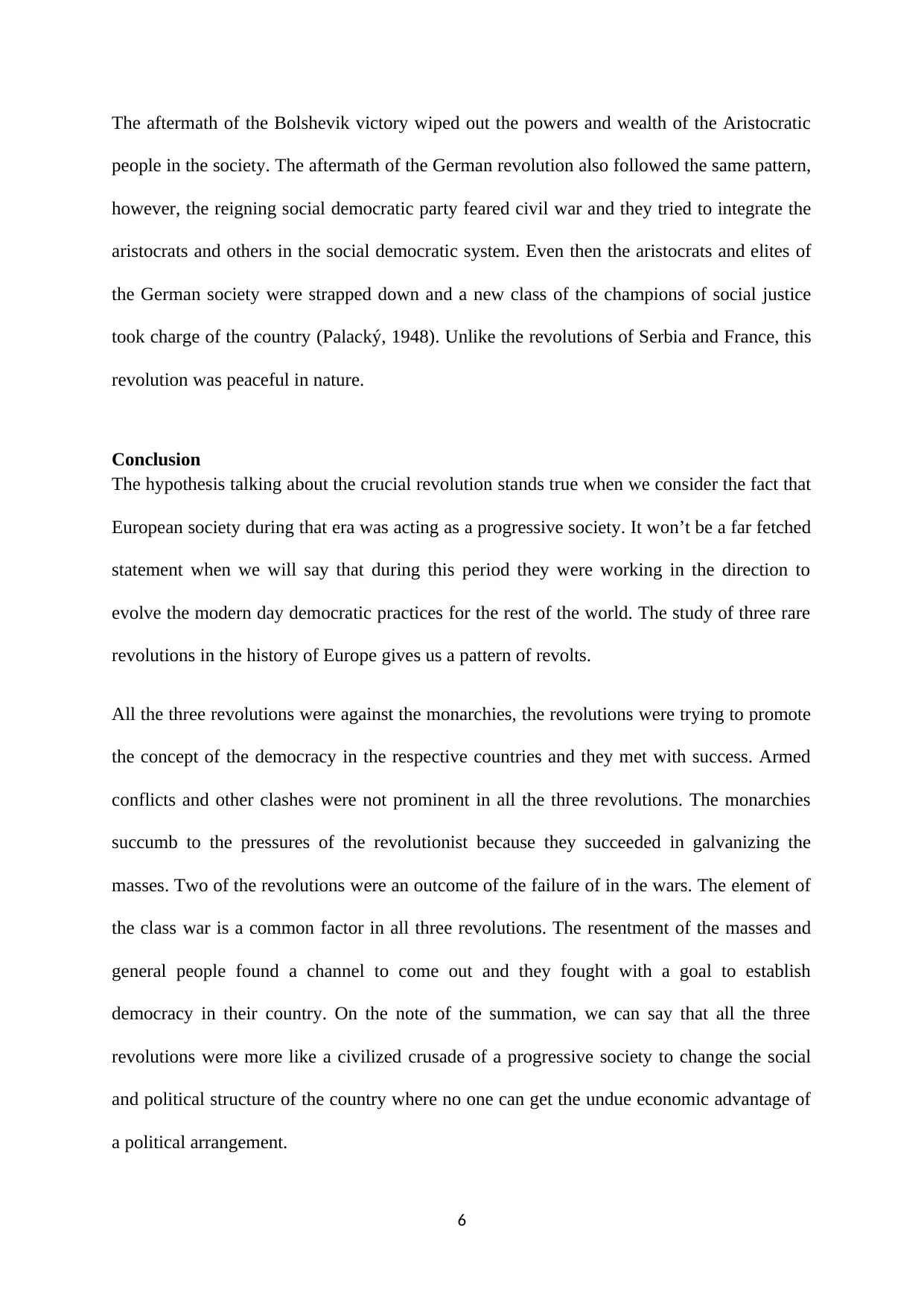
The aftermath of the Bolshevik victory wiped out the powers and wealth of the Aristocratic
people in the society. The aftermath of the German revolution also followed the same pattern,
however, the reigning social democratic party feared civil war and they tried to integrate the
aristocrats and others in the social democratic system. Even then the aristocrats and elites of
the German society were strapped down and a new class of the champions of social justice
took charge of the country (Palacký, 1948). Unlike the revolutions of Serbia and France, this
revolution was peaceful in nature.
Conclusion
The hypothesis talking about the crucial revolution stands true when we consider the fact that
European society during that era was acting as a progressive society. It won’t be a far fetched
statement when we will say that during this period they were working in the direction to
evolve the modern day democratic practices for the rest of the world. The study of three rare
revolutions in the history of Europe gives us a pattern of revolts.
All the three revolutions were against the monarchies, the revolutions were trying to promote
the concept of the democracy in the respective countries and they met with success. Armed
conflicts and other clashes were not prominent in all the three revolutions. The monarchies
succumb to the pressures of the revolutionist because they succeeded in galvanizing the
masses. Two of the revolutions were an outcome of the failure of in the wars. The element of
the class war is a common factor in all three revolutions. The resentment of the masses and
general people found a channel to come out and they fought with a goal to establish
democracy in their country. On the note of the summation, we can say that all the three
revolutions were more like a civilized crusade of a progressive society to change the social
and political structure of the country where no one can get the undue economic advantage of
a political arrangement.
6
people in the society. The aftermath of the German revolution also followed the same pattern,
however, the reigning social democratic party feared civil war and they tried to integrate the
aristocrats and others in the social democratic system. Even then the aristocrats and elites of
the German society were strapped down and a new class of the champions of social justice
took charge of the country (Palacký, 1948). Unlike the revolutions of Serbia and France, this
revolution was peaceful in nature.
Conclusion
The hypothesis talking about the crucial revolution stands true when we consider the fact that
European society during that era was acting as a progressive society. It won’t be a far fetched
statement when we will say that during this period they were working in the direction to
evolve the modern day democratic practices for the rest of the world. The study of three rare
revolutions in the history of Europe gives us a pattern of revolts.
All the three revolutions were against the monarchies, the revolutions were trying to promote
the concept of the democracy in the respective countries and they met with success. Armed
conflicts and other clashes were not prominent in all the three revolutions. The monarchies
succumb to the pressures of the revolutionist because they succeeded in galvanizing the
masses. Two of the revolutions were an outcome of the failure of in the wars. The element of
the class war is a common factor in all three revolutions. The resentment of the masses and
general people found a channel to come out and they fought with a goal to establish
democracy in their country. On the note of the summation, we can say that all the three
revolutions were more like a civilized crusade of a progressive society to change the social
and political structure of the country where no one can get the undue economic advantage of
a political arrangement.
6
⊘ This is a preview!⊘
Do you want full access?
Subscribe today to unlock all pages.

Trusted by 1+ million students worldwide
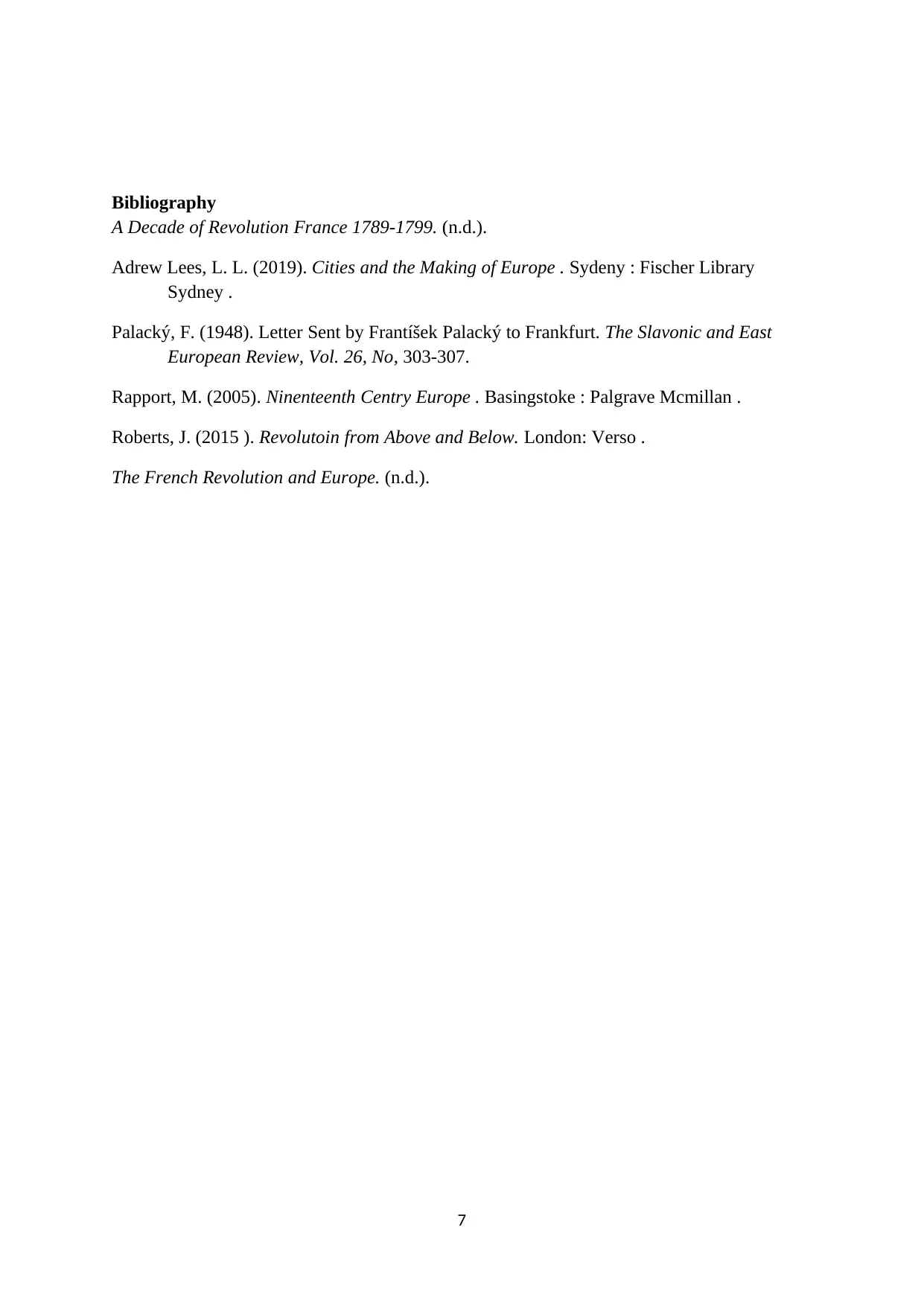
Bibliography
A Decade of Revolution France 1789-1799. (n.d.).
Adrew Lees, L. L. (2019). Cities and the Making of Europe . Sydeny : Fischer Library
Sydney .
Palacký, F. (1948). Letter Sent by Frantíšek Palacký to Frankfurt. The Slavonic and East
European Review, Vol. 26, No, 303-307.
Rapport, M. (2005). Ninenteenth Centry Europe . Basingstoke : Palgrave Mcmillan .
Roberts, J. (2015 ). Revolutoin from Above and Below. London: Verso .
The French Revolution and Europe. (n.d.).
7
A Decade of Revolution France 1789-1799. (n.d.).
Adrew Lees, L. L. (2019). Cities and the Making of Europe . Sydeny : Fischer Library
Sydney .
Palacký, F. (1948). Letter Sent by Frantíšek Palacký to Frankfurt. The Slavonic and East
European Review, Vol. 26, No, 303-307.
Rapport, M. (2005). Ninenteenth Centry Europe . Basingstoke : Palgrave Mcmillan .
Roberts, J. (2015 ). Revolutoin from Above and Below. London: Verso .
The French Revolution and Europe. (n.d.).
7
1 out of 7
Related Documents
Your All-in-One AI-Powered Toolkit for Academic Success.
+13062052269
info@desklib.com
Available 24*7 on WhatsApp / Email
![[object Object]](/_next/static/media/star-bottom.7253800d.svg)
Unlock your academic potential
Copyright © 2020–2025 A2Z Services. All Rights Reserved. Developed and managed by ZUCOL.



